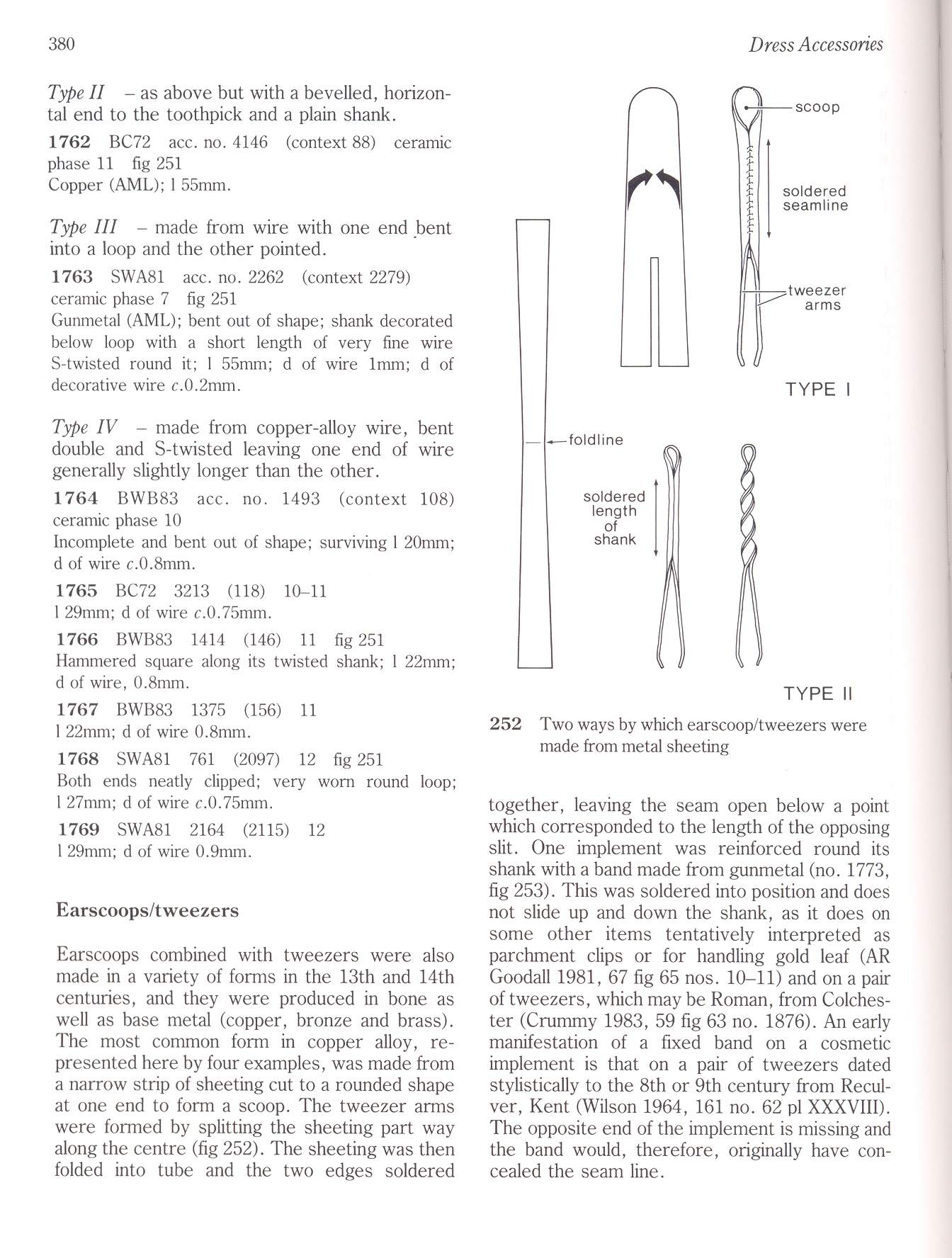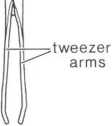407 (10)

380
Dress Accessońes
-scoop
soldered
seamline

TYPE I

Type II - as above but with a bevelled, horizon-tal end to the toothpick and a plain shank.
1762 BC72 acc. no. 4146 (context 88) ceramic phase 11 fig 251
Copper (AML); 1 55mm.
Type III - madę from wire with one end bent into a loop and the other pointed.
1763 SWA81 acc. no. 2262 (context 2279) ceramic phase 7 fig 251
Gunmetal (AML); bent out of shape; shank decorated below loop with a short length of very fine wire S-twisted round it; 1 55mm; d of wire lmm; d of decorative wire c.0.2mm.
Type IV - madę from copper-alloy wire, bent double and S-twisted leaving one end of wire generally slightly longer than the other.
1764 BWB83 acc. no. 1493 (context 108) ceramic phase 10
Incomplete and bent out of shape; surviving 1 20mm; d of wire c.0.8mm.
1765 BC72 3213 (118) 10-11 1 29mm; d of wire c.0.75mm.
1766 BWB83 1414 (146) 11 fig 251 Hammered sąuare along its twisted shank; 1 22mm; d of wire, 0.8mm.
1767 BWB83 1375 (156) 11 1 22mm; d of wire 0.8mm.
1768 SWA81 761 (2097) 12 fig 251
Both ends neatly clipped; very wom round loop; 1 27mm; d of wire c.0.75mm.
1769 SWA81 2164 (2115) 12 1 29mm; d of wire 0.9mm.
Earscoops/tweezers
Earscoops combined with tweezers were also madę in a variety of forms in the 13th and 14th centuries, and they were produced in bonę as well as base metal (copper, bronze and brass). The most common form in copper alloy, re-presented here by four examples, was madę from a narrow strip of sheeting cut to a rounded shape at one end to form a scoop. The tweezer arms were formed by splitting the sheeting part way along the centre (fig 252). The sheeting was then folded into tubę and the two edges soldered
n
-foldline
soldered
length
of
shank
TYPE II
252 Two ways by which earscoop/tweezers were madę from metal sheeting
together, leaving the seam open below a point which corresponded to the length of the opposing slit. One implement was reinforced round its shank with a band madę from gunmetal (no. 1773, fig 253). This was soldered into position and does not slide up and down the shank, as it does on some other items tentatively interpreted as parchment elips or for handling gold leaf (AR Goodall 1981, 67 fig 65 nos. 10-11) and on a pair of tweezers, which may be Roman, from Colches-ter (Crummy 1983, 59 fig 63 no. 1876). An early manifestation of a fixed band on a cosmetic implement is that on a pair of tweezers dated stylistically to the 8th or 9th century from Recul-ver, Kent (Wilson 1964, 161 no. 62 pl XXXVIII). The opposite end of the implement is missing and the band would, therefore, originally have con-cealed the seam linę.
Wyszukiwarka
Podobne podstrony:
425 (10) 398 Dress Accessories surfaces. Many objects had evidence of tin coat-ing (colour pis 4G &a
431 (10) 404 Dress Accessońes —, 1987 ‘Report on the Composition of the Ingots and Axle-Cap’, in Mea
403 (10) 376 Dress Accessońes only 6d per lb (Staniland 1986, 240). The painting and gilding of boxw
419 (10) 392 Dress Accessories cases, though it is likely to have been present. Brass mount no. 935
str152 153 fm =fhk = 0,082(1-O,OkDp* - wzór 7.4.2.1.b z PN-B-03150:2000, Aok = 0,082(1-0,01 • 10)380
45704 Obraz 6 (10) 380 O poezji naiwnej i sentymentalnej dostarczała materii poezji satyrycznej i el
274 (42) Dress Accessońes 246 1078 805 1095 (A) mounts with fields of dots (1:1) (
276 (40) 248 Dress Accessońes because no indication has been recognized on them of the wearer’s adhe
278 (40) 250 Dress Accessories 1314 1311 SWA81 2186 (2055) 9 fig 160 Corroded
284 (41) 256 Dress Accessońes Hooked annular brooch Copper alloy 1338 SWA81 acc. no. 1493 (context
286 (34) 258 Dress Accessońes 166 Pentagonal, hexagonal and six-lobed brooches -odginał shapes resto
292 (37) 264 Dress Accessories 1365 171 Yiolet brooches (drawings 1:1, photograph 2:1) (?)flower bud
296 (37) 268 Dress Accessońes Brooches with circular frames Leaf 1374 BC72 2037 (83) 11 fig 174 Poss
298 (39) 270 Dress Accessories Table 5 Brooches - metals used 1 1 Copper i i 2 I I I -1-1—[— 1 1 1
302 (41) 274 Dress Accessońes buttons of the former kind, found in Lund in Sweden). Composite sheeti
304 (37) 276 Dress Accessońes slightly damaged (an impressed dot here may not be an original feature
306 (35) 180 180 278 Dress Accessońes Cloth buttons and corresponding holes on a sleeve from a depos
308 (39) 280 Dress Accessońes late 13th century onwards. The alloys used in buttons prior to that co
310 (36) 282 182 Lace chapes: terminology Dress Accessories O edge to edge seam overlapping seam end
więcej podobnych podstron